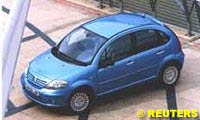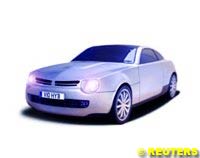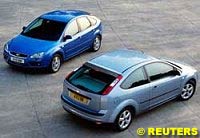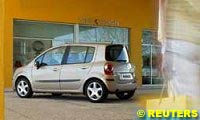

Automotive News and Reviews for the Petrolhead
In this week's issue:
- Car Briefs
- Mercedes Sticks to Sales Goal
- Porsche Set to Roll Out New Boxsters
The Stop & Start system is claimed to reduce fuel consumption by 10% for city driving, 6% in a standard combined cycle and up to 15% in heavy traffic. In fact, like most new technology, it is an old idea: VW tried it on a Golf over 20 years ago. The difference now is that modern electronics are clever enough, and cheap enough, to make the system commercially viable.
The performance targets are: 140mph, 0-60mph in 6.2s, 42mpg and genuine 2+2 seating configuration. Unfortunately, apart from the 2+2 seating, you can buy a Lotus Elise today that will do 41 mpg and accelerate to 60 in 5.1 seconds.
Providing that the new model drives as entertainingly as the old one, while adding a quality look and feel, the Focus 2 should maintain its status as a best-seller.
The Modus is the seventh Renault to achieve a five star Euro NCAP rating which, Renault claims, makes them the safest range of cars on the market. Only the Clio and Kangoo miss out on the maximum score, both achieving four stars.
DaimlerChrysler has stuck to its forecast for 2004 sales growth at the prestigious Mercedes Car Group, even though sales at its flagship auto division fell in August for the seventh month this year.
Turnover retreated 7.8 percent versus August 2003 to 77,300 units as rising sales of Smart compact cars were unable to offset a decline in Mercedes-Benz cars. Divisional sales declined 4.7 percent in the first eight months of 2004 to 760,300 vehicles, the company said on Monday, citing disruptive but rejuvenating model changeovers this year.
The world's fifth-biggest carmaker said it expected a sales boost in the fourth quarter from its revamped A-class small car, which arrives in dealer showrooms this month. Orders for the A-class have already surpassed the 50,000 cars it aimed to sell in 2004.
"We confirm the outlook," a spokeswoman said, reiterating that Mercedes-Benz sales should come in near the 2003 level of 1.1 million while turnover of the Smart series could hit 175,000, thanks in part to the new Smart ForFour four-passenger version.
Turnover of Mercedes brand vehicles slipped 9.3 percent in August to 69,000 units, while sales of the tiny Smart range of cars rose 7.3 percent to 8,300 units.
Divisional sales slumped 17.6 percent last month in Germany, its biggest market, which is suffering through a dismal year with scant sign of improvement. Other parts of the world were also weak, but U.S. sales of Mercedes cars rose 2.3 percent.
Trucks on the Move
Mercedes Car Group includes Mercedes-Benz, the Smart range and the super-luxury Maybach limousine.
Daimler hopes the relaunch of Mercedes-Benz C-class sedans, SLK roadsters and the new Smart ForFour compact -- the brand's largest car to date -- will help spur sales at its most lucrative business, which in July abandoned its target of matching 2003 earnings this year.
It warned in July that profits would be hit by a changed model mix, the cost of new launches, adverse currency influences and stepped-up spending to fix quality problems that have tarnished its image. On a brighter note, DaimlerChrysler expects solid sales growth at its commercial vehicles division this year, the world's biggest maker of trucks and buses.
In a slide posted on its Web site to accompany a presentation by division chief Eckhard Cordes to analysts, the company forecast 2004 revenue of 33 billion euros at the division, helped by the integration of Japanese unit Mitsubishi Fuso.
The truck and bus division had 2003 revenue of 28.5 billion euros (19.3 billion pounds). Its revenue had risen 26 percent in the first half of 2004 to 15.6 billion, a gain of 32 percent excluding exchange rate swings. It has consolidated Fuso sales since April 2004.
The company said sales of its second-generation Actros heavy truck model were beating expectations, forecasting Actros sales would rise to 55,000 in 2004 from 46,000 in 2003.
Porsche will roll out new, more powerful versions of its Boxster and Boxster S roadsters in Europe on November 27, the German sports carmaker says.
The six-cylinder models go on sale in the United States from January 15.
Sales of the two-seat, mid-engine cars that were introduced in 1995/96 have been fading since peaking at 27,865 units in its 2000/01 fiscal year. The new 2.7-litre Boxster boasts 240 horsepower, 12 more than now, while the 3.2-litre Boxster S adds 20 horsepower to 280.
The basic model has a top speed of 256 km per hour and goes from zero to 100 in 6.2 seconds. The S version reaches 268 km/hour and hits 100 from a standing start in 5.5 seconds. The Boxster will cost 37,000 euros (25,200 pounds) and the Boxster S 44,100 euros excluding tax and any country-specific equipment.
Porsche, which rolled out a new version of its flagship 911 sports car in July, gave no sales forecasts for the Boxsters.
![]() Car Briefs
Car Briefs
 Citroen has announced its "Stop & Start" system, whereby the engine is automatically turned off and is in standby mode when the vehicle stops at traffic lights and traffic jams. The engine instantly starts up again when the brake pedal is released, with the vehicle pulling away once the accelerator is pressed. The CitroŽn C3 1.4i 16V Stop & Start, which will be available from November with the SensoDrive clutchless manual transmission, will be the first mass-produced car wit this feature.
Citroen has announced its "Stop & Start" system, whereby the engine is automatically turned off and is in standby mode when the vehicle stops at traffic lights and traffic jams. The engine instantly starts up again when the brake pedal is released, with the vehicle pulling away once the accelerator is pressed. The CitroŽn C3 1.4i 16V Stop & Start, which will be available from November with the SensoDrive clutchless manual transmission, will be the first mass-produced car wit this feature.
 An ambitious, if slightly strange, sports car has been announced by two ex-Jaguar consultant engineers, Tim Bishop and Tony Martindale. Called the Connaught Type-D, the project has to date received almost half a million pounds worth of funding from the Energy Saving Trust. The company insists that, despite the 1950s name (Connaught was a well-known racing car manufacturer of the time and Type-D obviously comes from the D-Type Jaguar), this is a modern project that will use hybrid (petrol plus electric power) for outstanding economy. The engine is planned to be a 2.1 litre V10 petrol, which sounds like at least four cylinders more than strictly necessary. The target price is £35,000 - oh, and £5 million to put the car into production, if any Russian oligarchs are reading this.
An ambitious, if slightly strange, sports car has been announced by two ex-Jaguar consultant engineers, Tim Bishop and Tony Martindale. Called the Connaught Type-D, the project has to date received almost half a million pounds worth of funding from the Energy Saving Trust. The company insists that, despite the 1950s name (Connaught was a well-known racing car manufacturer of the time and Type-D obviously comes from the D-Type Jaguar), this is a modern project that will use hybrid (petrol plus electric power) for outstanding economy. The engine is planned to be a 2.1 litre V10 petrol, which sounds like at least four cylinders more than strictly necessary. The target price is £35,000 - oh, and £5 million to put the car into production, if any Russian oligarchs are reading this.
 The new Ford Focus will go on sale in January 2005. Ford has not yet allowed journalists to drive the car, but Ford's strategy is fairly clear, nonetheless. The current Focus has been the best handling car in its class since its launch six years ago, so now Ford wants to concentrate on other areas. The main failing of the current car is its busy dashboard which looks over-styled and under-engineered compared to a Golf. This time, Ford wants to create a level of interior quality traditionally associated more with small Audis than medium-sized Fords. The styling is evolutionary, but smoothed off compared to the "New Edge" Focus 1. Ford hints that the old model was trying just a bit too hard, a bit too "in-your-face": this one is meant to have a more grown-up look.
The new Ford Focus will go on sale in January 2005. Ford has not yet allowed journalists to drive the car, but Ford's strategy is fairly clear, nonetheless. The current Focus has been the best handling car in its class since its launch six years ago, so now Ford wants to concentrate on other areas. The main failing of the current car is its busy dashboard which looks over-styled and under-engineered compared to a Golf. This time, Ford wants to create a level of interior quality traditionally associated more with small Audis than medium-sized Fords. The styling is evolutionary, but smoothed off compared to the "New Edge" Focus 1. Ford hints that the old model was trying just a bit too hard, a bit too "in-your-face": this one is meant to have a more grown-up look.
 The Renault Modus mini-MPV has been awarded the maximum five star rating by Euro-NCAP, the first car in its class to be given this award. The car also scored a best-in-class four stars for child safety - an important achievement for a family-oriented vehicle. Renault is particularly proud of these results because high scores are more difficult with smaller cars than with larger cars; in simple terms, smaller cars have less metal to absorb the impact. Safety features of the Modus include a magnesium steering wheel frame which deforms on impact, a steering column which retracts to increase the space for occupants and a brake pedal which collapses to the floor to reduce the risk of lower limb injury.
The Renault Modus mini-MPV has been awarded the maximum five star rating by Euro-NCAP, the first car in its class to be given this award. The car also scored a best-in-class four stars for child safety - an important achievement for a family-oriented vehicle. Renault is particularly proud of these results because high scores are more difficult with smaller cars than with larger cars; in simple terms, smaller cars have less metal to absorb the impact. Safety features of the Modus include a magnesium steering wheel frame which deforms on impact, a steering column which retracts to increase the space for occupants and a brake pedal which collapses to the floor to reduce the risk of lower limb injury.
![]() Mercedes Sticks to Sales Goal
Mercedes Sticks to Sales Goal
![]() Porsche Set to Roll Out New Boxsters
Porsche Set to Roll Out New Boxsters
| Contact the Editor |
© 1995-2005 Kaizar.Com, Inc. . This service is provided under the Atlas F1 terms and conditions.
|
Volume 10, Issue 36
Articles
Exclusive Interview with Eddie Jordan
The Tifosi and the Samurai at Monza
Technical Analysis: 2005 Proposals
2004 Italian GP Preview
2004 Italian GP Preview
Italian GP Facts & Stats
Columns
The F1 Trivia Quiz
Rear View Mirror
Bookworm Critique
On the Road
Elsewhere in Racing
> Homepage |